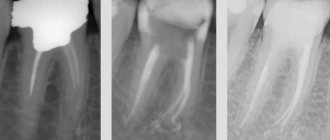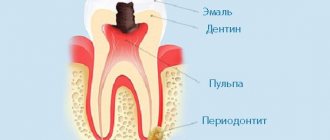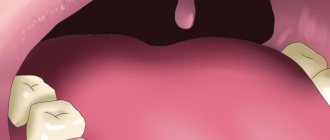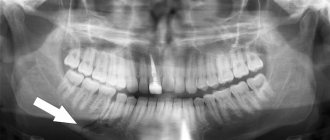Sometimes the pain that occurs after recently treated pulpitis is a natural phenomenon, but it may also be that the cause of the pain is mistakes made by the dentist. Statistics are not on the side of dentists: according to it, in approximately 60% of cases, treatment of pulpitis is carried out with gross violations, leading to not the most pleasant consequences.
To avoid problems in the future, after treatment it is necessary to take an x-ray: from the image it will be possible to immediately determine whether the doctor filled the root canals properly. But, again, according to statistics, in more than half of the cases, doctors, seeing the shortcomings of their own work, do nothing, and the absolute majority of patients do not know how to read x-rays. Why does this happen? Firstly , treating pulpitis is a troublesome and lengthy task, and secondly , errors will not manifest themselves immediately, but only towards the end of the treatment guarantee, when the patient will no longer have the right to make claims.
Tooth hurts after pulpitis treatment due to injured tissue near the root
The first stage of treatment for pulpitis is the removal of the inflamed pulp, after which the canals are sealed so that subsequently the inflammatory process does not begin to develop in them again. During the procedure, minor tissue trauma occurs, which simply cannot be avoided.
Pain may occur due to:
- separation of a bundle of nerves located near the upper part of the root, which often occurs when removing pulp;
- mechanical treatment of the canals with special tools (very often the tool can extend beyond the canal, causing injury to the tissues located near the apex of the tooth root);
- penetration of antiseptic agents used to flush the canals outside of them, which can cause irritation.
In all of the above cases, pain is a natural reaction of the body. After proper treatment, pain will stop within a maximum of 3 days.
When there is no need to see a doctor
Why does a tooth hurt after pulpitis? The appearance of pain is due to the increased trauma of the entire procedure, which consists of opening the tooth, removing pulp from the root canal and filling the empty space with artificial material - a filling.
How long does a tooth hurt after pulpitis in normal condition? Without pathologies, the pain persists for 5-10 days, and it gradually subsides. It is considered normal when:
- after pulpitis, the tooth hurts without increasing pain;
- there is no bleeding, swelling, swelling or redness, general weakness, or fever.
A tooth hurts due to a poorly filled canal
A feeling of pain and swelling of the gums are the first signs that the tooth treatment was performed poorly. However, there are situations when the inflammatory process develops slowly, and it is possible to understand that something is wrong with the tooth only by taking a picture.
As mentioned above, filling canals is a common procedure, often performed with errors: if they are not corrected, then after some time inflammation and, consequently, pain will begin.
There are the following options for unsatisfactory filling:
- The canal was not sealed to the entire length of the root. The pulp becomes inflamed due to microorganisms that have entered it. After its removal and thorough treatment of the canal with drugs, some part of the microflora still remains. When the canal is not filled along its entire length or the filling material is not compacted tightly, the infection multiplies and affects the tissue surrounding the tooth. Eventually, a sac filled with pus appears at the apex of the root. If the doctor has not completely filled the canal, then the tooth must be re-treated (the sooner this is done, the greater the chances of saving it). Usually, a complete unfilling of the canal and its re-sealing is required. When the canal is unsealed only in the area of the upper part of the root, the doctor can perform a resection, which allows the canal not to be unsealed.
- Exit of filling material beyond the root apex. One of the causes of pain is the removal of the material used for filling beyond the upper part of the root. There is no universal method for eliminating the deficiency: a preliminary examination by a doctor is required. If little material has been removed, the pain will subside over time (in some cases you will have to wait up to 2 months). In this case, the patient is given a choice: either tolerate a slight reduction in pain, or agree to re-treat the tooth. If a lot of material has been removed, surgical intervention will be required: the doctor will make a small hole in the bone through which he can remove excess material (a simple operation takes about half an hour).
- Leaving a broken part of a medical instrument in the canal. When processing the canal, the instruments used by the doctor may break off. There may be several reasons for this: careless actions of the dentist; curved channels. Sometimes it is possible to get a fragment out, but if a piece of the instrument remains in the upper third of the root, it becomes very difficult to remove it. The broken part does not allow filling the entire length of the canal. There is a risk of infection multiplying, which can provoke the development of an inflammatory process in the tissues surrounding the tooth.
- Root perforation. Perforation is a small hole that appears in the root either due to natural causes (excessive curvature of the canals, but this happens rarely), or due to the actions of a doctor. Today, perforation is a very intractable problem in dentistry. Most often, perforation occurs when a pin is installed, when it is not fixed in the canal, but is brought out through its wall directly into the bone. If the canal is very curved or difficult to navigate, then working in it requires great precision from the doctor. But even extreme accuracy does not guarantee that mistakes will be avoided. Often, high-quality treatment of curved canals becomes a difficult task for an experienced doctor.
Perforation can be corrected, but it is difficult to do. To properly close the hole, expensive materials like Pro Root MTA are used. Sometimes filling with this material can be done from the inside of the tooth, sometimes surgical access to the area where the perforation has occurred is required. If the doctor is to blame for its appearance, then the hospital must correct the shortcomings at its own expense.
Reason to visit the dentist again
If after treatment for pulpitis you continue to experience pain for a long period of time, it intensifies, the gums become red and/or swollen, or your body temperature rises, you should immediately consult a dentist.
Why shouldn't you put off visiting the doctor? If discomfort in a tooth occurs due to perforation or root fracture, then without adequate therapy the patient may be left without a tooth. And periodontitis can lead to complications such as the formation of cysts and granulomas. Important: the state of health and well-being is affected by a sluggish inflammatory process in the teeth, which is why it is so important to eliminate it in a timely manner.
Some patients, if they are bothered by painful sensations, run to the dentist immediately after therapy. Even if the treatment was performed correctly, pain may persist for several days (up to 3) after the manipulation. Discomfort for several months is considered normal, but only if it gradually subsides and the tooth does not bother you when biting or eating hot/cold food.
Specialist actions
The dentist is obliged to admit the patient and conduct an examination, assess the condition of the tissues that surround the tooth. In this situation, you cannot do without an x-ray. This will allow you to assess the quality of treatment, as well as diagnose complications or their absence.
If the painful sensations are not associated with complications of therapy or pathology, the doctor will prescribe painkillers to the patient and also advise him to monitor his condition.
The examination confirmed the worst assumptions and the patient has complications? In such a situation, the dentist will decide what further treatment tactics should be. The specialist must assess the patient’s condition.
What should you do if the doctor refuses to examine you, convinces you that the therapy was carried out correctly, but does not conduct an examination? In such a situation, you should not give up; you need to visit another doctor who will listen carefully, conduct an examination (if necessary, take a panoramic photo and x-ray). If an inflammatory process was detected during the examination, the dentist will draw up a treatment plan, perhaps this will be surgical therapy. Without this, complications may arise such as:
- periapical abscess;
- periodontitis;
- osteomyelitis;
- orbital cellulitis.
And the spread of infection from the upper teeth is fraught with purulent sinusitis, brain abscess, meningitis and cavernous sinus thrombosis.
Choosing a dental clinic
The Vash Dentist clinic provides high-quality dental services. We employ highly qualified specialists with extensive experience. It's no secret that most dentists, despite modern methods of therapy, still use “old-fashioned” methods of treatment, which most often result in tooth extraction. During treatment, doctors at our clinic use modern technologies, instruments and professional equipment.
We have the necessary certificates and licenses, all services are provided at a high level.
On our website you can find out how therapy is carried out and how much this service costs. On our website you can choose a specialist and make an appointment with him.
If you contact our clinic for treatment of pulpitis, you will not be bothered by pain after therapy. Without fail, the doctor will warn you about what consequences the treatment may entail and give recommendations on how to eliminate them as quickly as possible. If you have any questions after the manipulations, you can always seek qualified advice.
How is canal filling performed?
High-quality filling is the key to the absence of complications in the future. Before filling, the canals must be prepared: widen them slightly and ensure patency along the entire length.
Preparation consists of the following steps:
- elimination of tissues on which carious formations have appeared (removal of healthy tissue is allowed in order to gain access to the orifices);
- complete removal of the pulp;
- correct determination of the channel length (they are different in length);
- high-quality mechanical processing (includes expanding the diameter of the channel along the entire length);
- filling with gutta-percha.
The quality of the filling depends on:
- Correct determination of the channel length. In case of a dentist’s mistake, the canal may be either underfilled, which subsequently leads to the formation of cysts, or overfilled when the material extends beyond the boundaries of the root (consequences - pain, inflammation).
- High quality machining. The purpose of the procedure is to widen the canal so that it can be filled with filling material to its full length. Treatment can be carried out either using hand instruments, which the doctor rotates in the canal with his fingers, or using an endodontic tip (rotating in the canal, they remove a thin layer from the walls, gradually expanding it). This option is the most preferable, since the quality of processing increases and safety increases (the tip cannot break off due to automatic control of the load level).
- The chosen filling method and the doctor’s competence.
The patient can understand without the help of a doctor how well the canal was filled. To do this, you need to carefully look at the x-ray:
- The filling material will appear as a rich white color. This color should fill the channel throughout its entire length;
- in a properly sealed canal there should be no voids or gaps.
Is it painful to treat pulpitis?
Treatment of pulpitis is painless, since before drilling the dentist injects the gum with an anesthetic drug. After 2-4 minutes the pain goes away, only a sensation of touch or pressure remains.
Before injecting an anesthetic, the doctor may suggest topical anesthesia, that is, lubricate the gums with a “freezing” gel so as not to feel the insertion of the needle. Another popular service that complements anesthesia is sedation. The patient inhales special sedatives, completely relaxes and even falls asleep.
For allergy sufferers, hypoallergenic drugs are chosen; in extreme cases, the dentist may suggest treatment under anesthesia. Unlike local anesthesia and sedation, anesthesia negatively affects the cardiovascular system and the entire body as a whole.
Brief conclusions
The main consequences of poor treatment of pulpitis are as follows:
- flux, formation of cysts in cases where the canals are not completely filled, periodontitis;
- prolonged pain and neuralgia during repeated canal filling.
One of the most unpleasant consequences for the patient is tooth extraction. It cannot be avoided if:
- the doctor during the treatment broke the root or caused a perforation, which was not eliminated as soon as possible;
- A periodontal abscess formed at the root apex, and the patient delayed its treatment.
Content:
- Abnormal factors causing the problem 1.1. Traumatic injury 1.2. Mistakes made during filling 1.3. Tool fragment 1.4. Wall perforation 1.5. Periodontitis
In certain cases, pain after pulpitis treatment may be normal.
Even if during the procedure the entire pulp was completely removed and there seems to be nothing left to hurt, discomfort may still occur. Why is this happening? It's all about getting the treated tissues used to the filling composition embedded in them. If the intervention was carried out efficiently and in compliance with all standards, the unpleasant sensations will soon go away on their own.
If the pain does not subside, but, on the contrary, becomes more severe, increases every day, the gums are swollen, and other dangerous accompanying symptoms appear - this is a reason to consult a dentist. It is quite possible that the inflammatory process is progressing in the tissues, which is important to stop as quickly as possible.
How long does pain last after pulpitis if treatment is successful?
To cure pulpitis, you may need 2-3 visits to the dentist. During the first visit, the doctor cleans the crown of carious tissue and drills the tooth to get to the pulp chamber. Having removed the pulp from the crown, it cleans and disinfects the root canals, and then fills them. A temporary filling is placed on the crown to monitor the results of the treatment.
After filling, the doctor warns about possible sensations that are considered normal after complex treatment:
- It's a dull pain . Appears immediately after the “freezing” has passed. It is weaker than with pulpitis and is associated with the removal of part of the neurovascular bundle. Gradually goes away within 1-3 days;
- The impression is that the tooth rises above the rest and is in the way. May last a week or more;
- Pain when biting . It gradually decreases over 7-10 days.
In the first hours after treatment, you can take a tablet analgesic yourself. It is better to use an antibiotic or rinse only as prescribed by a doctor.
By the second visit, the pain usually goes away completely. Often, when a temporary filling is replaced with a permanent one, anesthesia is not even given. On the third visit, the crown is restored, which is also painless for a pulpless tooth.











